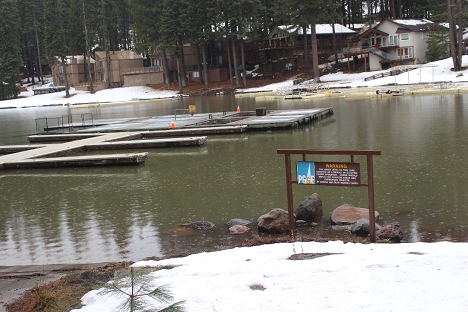
The Lake Almanor Fish Pen Program is the largest and most successful fish pen project in the State of California. It is located in the Hamilton Branch area at the intersection of Hwy. 147 and County Road A-13 at the northeast corner of Lake Almanor. This area is one of the most popular bank fishing areas for anglers and their families. The facilities at the public access area are maintained by the association which hosts parking, picnicking, and toilets (in season).
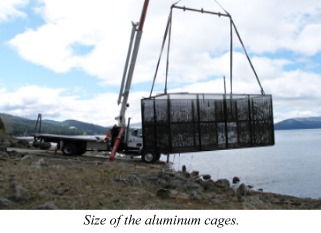
Historically, 50,000 trout are delivered each year by the DF&W. It takes 15,000 pounds of fish food during the time the fish are in the cages until they are released into the lake. To date, Jim, Reuben, and the association have released approximately one million nine hundred thousand trout into the lake for the enjoyment of anglers. In 2019 AFA added two additional pens and docking bringing our holding capacity to 60,000 fish. This year in addition to the 50,000 fertile West Virginia Rainbows in ten fish pens there are 6,500 Browns from Feather River College in our two newest pens.
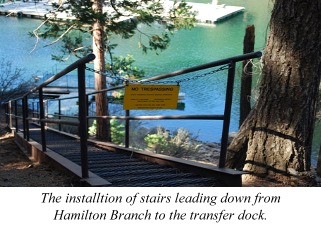
Fish get delivered to Lake Haven (thank you Dave and Judith for your continued support) via DFW trucks and are unloaded to a transfer cage. The fish are then taken via boat to the aluminum holding cages in Hamilton Branch where they remain for the winter. AFA volunteers feed the fish daily throughout the winter and early spring. When the fish are delivered, they are classified as sub-catchable (ten to the pound) and an average 4-6 inches long. When the fish are released in late April or early May, they have more than doubled in size measuring 10-12 inches in length. After the release of fish, the cages remain anchored in the Hamilton Branch to await next year’s delivery.
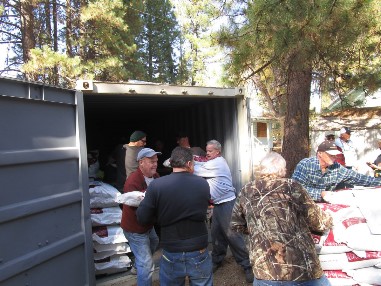
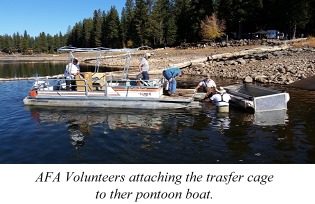
AFA coordinates the delivery of fish weeks in advance to give the hatchery notice. AFA volunteers perform the transfer over the course of two days weather depending on and availability of CFW trucks. AFA volunteers begin feeding the day after delivery. The 40-pound sacks of fish food are taken from a Conex container, carried down a flight of stairs and placed on our transfer boat, where a minimum of two AFA volunteers pull the transfer boat over to the fish pens. This small feat becomes much more trying when Plumas County weather rears its ugly head.
The history of the “Longest Running Most Successful Fish Pen Program” in the State of California. The Fish Rearing Cage Program was established in 1985 in the Hamilton Branch area by two local fishermen, Jim Pleau and Reuben Chavez with the assistance of Ron DeCoto, a biologist with the Department of Fish & Game (DFG). They started with two nylon net pens which were located at Lassen View Resort owned by Jim, Reuben and their wives Julie Chavez and Toni Pleau. The DFW provided the fish via hatcheries, DFW also provided food to feed the fish, acquired the necessary permit from PG&E to have the nylon nets in the waters of Lake Almanor, and took responsibility for maintenance of the net cages.
The cage program was highly successful; so much so that DFG decided to provide two aluminum cages which were a much sturdier structure than nylon nets. It was at this time that the Almanor Fishing Association (AFA) was established.
1988 DFG provided eight more aluminum cages from a failed Lake Orville cage program, In addition, stairs were installed by the Screen Shop out of Redding, CA. and paid for by DFW. That brought the number of cages up to ten, in 2019 AFA added two additional pens bringing the current total to twelve pens. Each pen is 16’long x 8’wide x 8’deep and can hold up to 5,000 fish. The stairs lead down from the top of Hamilton Branch to a transfer dock used to get access to the cages. In our early years CF&W covered the cost for all the cage maintenance, delivery of fish, and fish food. The Almanor Fishing Association continued to be responsible for feeding the fish during the winter months (October – April). The Association did minor maintenance to the cages, docks, and pontoon boats during those early years.
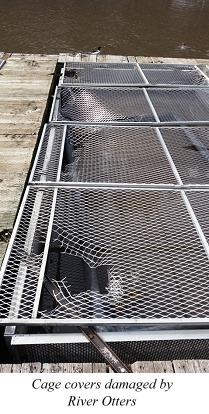 In the fall of 2007, DFG transferred ownership and maintenance of the 22-year-old fish rearing cage program to California Inland Fisheries Foundation Inc. primarily because the state could no longer afford to pay for the maintenance and the fish food. In 2009 Kokanee Power was granted ownership to cover the fish food, insurance liability, and permit from PG&E for the project. AFA took ownership of the maintenance and continued responsibility for feeding the fish. That same year the cage program was in danger of ending because of the condition of the cages. After 22 years in the water, they desperately needed repairs; the supporting timber and floats were water-logged and looked like one big storm away from breaking apart. The AFA Board of Directors and membership were genuinely concerned and wanted to keep this program moving forward. In 2010 and 2011 repairs on the pens were done by volunteers with financial support from CIFFI, Kokanee Power, and the Plumas County Fish and Game Commission. Brett Womack of Almanor Dock Supply was also instrumental with the platform work that was needed. In the end, the five wooden platforms and ten aluminum pens were successfully repaired!
In the fall of 2007, DFG transferred ownership and maintenance of the 22-year-old fish rearing cage program to California Inland Fisheries Foundation Inc. primarily because the state could no longer afford to pay for the maintenance and the fish food. In 2009 Kokanee Power was granted ownership to cover the fish food, insurance liability, and permit from PG&E for the project. AFA took ownership of the maintenance and continued responsibility for feeding the fish. That same year the cage program was in danger of ending because of the condition of the cages. After 22 years in the water, they desperately needed repairs; the supporting timber and floats were water-logged and looked like one big storm away from breaking apart. The AFA Board of Directors and membership were genuinely concerned and wanted to keep this program moving forward. In 2010 and 2011 repairs on the pens were done by volunteers with financial support from CIFFI, Kokanee Power, and the Plumas County Fish and Game Commission. Brett Womack of Almanor Dock Supply was also instrumental with the platform work that was needed. In the end, the five wooden platforms and ten aluminum pens were successfully repaired!
In 2015 the Darrah Springs Hatchery was quarantined due to the result of the whirling disease and shut down. Darrah Springs has been the sole supplier of the fish for our program. CF&W informed AFA that we would not be receiving fish for the 2015/16 cage program. At that time, most of our pen lids were damaged and in need of repair. After much debate, the AFA Board decided it would be in the best interests of the program to hold off on the repairs until the following year. AFA President Rich Dengler and Vice President Eric Rudgers continued to search for fish. In late September, the Shasta Hatchery, which was also quarantined due to the Whirling Disease, was removed from the closure, and delivered 30,000 Shasta Lake Trout. AFA volunteers spent countless hours cleaning, repairing, and prepping six cages to accommodate the 30,000 fish. Throughout the Winter, the pens and lids took a beating. Strong winter storms, debris from the Branch, otters and birds breached the lids, and we lost a large number of fish. By the end of the season, we had fish in three cages, and we were able to release approximately 15,000 of the original 30,000 fish delivered. Some of the missing 15,000 fish breached the cages and made it into the lake safely, just sooner than we had hoped.
In 2016 we were dealt an unexpected blow when our financial partner Kokanee Power elected to no longer participate in our cage program. This left AFA with the daunting task of repairing pen lids, purchasing food, securing insurance, and acquiring all permits. By this time the AFA Board and members had become accustomed to adversity, we bonded together and made the necessary repairs to the pen lids. Volunteers removed all forty lids, drilled out over 2000 rivets, Gary Ponciano of G&B Welding custom cut the heavier aluminum mesh, tack welded the mesh to the frames and volunteers installed rivets and returned the lids to the pens. AFA spent over $9,000 repairing the pen lids. Needing to raise additional funds the Almanor Community concentrated our collective efforts to host one of our most successful annual picnics. We had over 450 people turn out to support our only fundraising event.
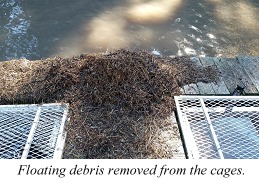
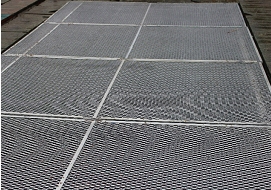
With a determined board, supporting community and dedicated volunteers our cage program was back on track. DF&W was still recovering from drought and the impact of the Whirling Disease, so we would only receive 25,000 fish for our 2016/17 cage program. Divers from DF&W inspected our cages and deemed eight were capable of holding fish. We were set to go, food was purchased, insurance in place, cages cleaned, and our fish were delivered. Things were finally looking up for our Cage Program, then we were devastated by a series of winter storms that we have not witnessed in more than 20 years. Snow followed by atmospheric rivers that dumped over three inches of rain on top of the snow resulted in a raging river of water down Hamilton Branch that busted our transfer dock and tore our fish cages apart. Feeders found two docks spinning in the turbulent waters with four pens attached to one section and six pens (five with fish) thirty yards up stream. The pens with fish had more than two solid inches of debris that had to be removed prior to feeding. Feeders had to boat in to remove debris and access damage, fortunately the fish proved to be as resilient as our volunteers. After cleaning out the pens, checking anchors and chains we found the fish to be alive, healthy, and hungry with a total of five perished fish.
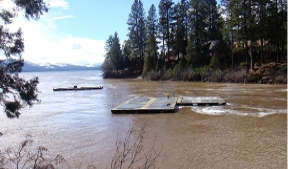
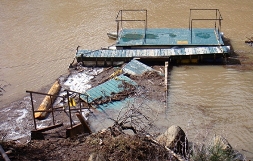
After much debate, it was decided the pens could not remain in Hamilton Branch, we contacted Brett Womack, and he moved the pens to Big Cove and reattached the docks. The fish enjoyed their new environment, and the Almanor Fishing Association Fish Pen Program continues to be the premier cage program in the State of California.
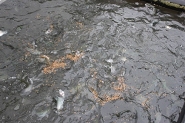
A big thank you goes to Jim Pleau, Reuben Chavez and Ron DeCoto for their foresight and initiative; PG&E for their long-standing support; partner CF&W for their continued support, California Inland Fisheries Foundation Inc. and Kokanee Power for their past financial support; Brett Womack and Almanor Dock Supply for helping in a time of need; the many, many volunteers for their eagerness to do good and be personally motivated to support the pen project regardless of need – install cage pens and docks, build stairs and parking lots, transport fish and fish food, feed fish throughout winter and early spring come rain, sleet, snow, or ice; and, most importantly, to Paul Garrido for his many years of devotion and unselfish desire to keep the pen program alive.

